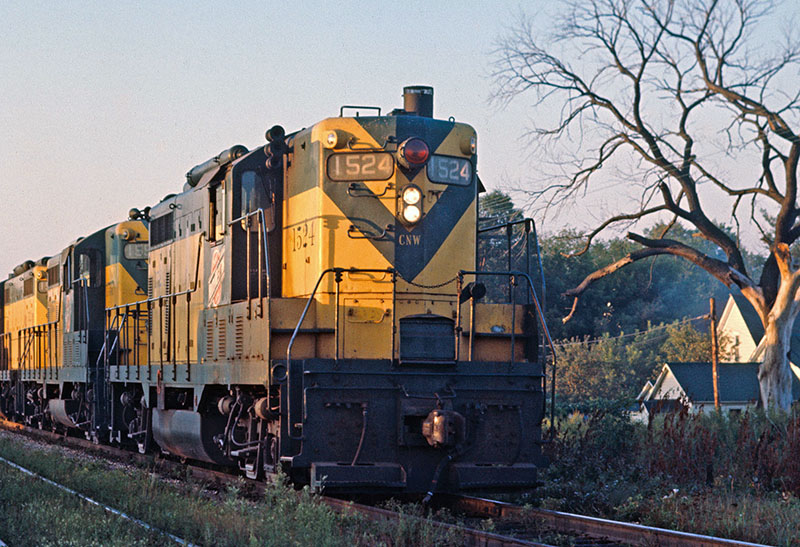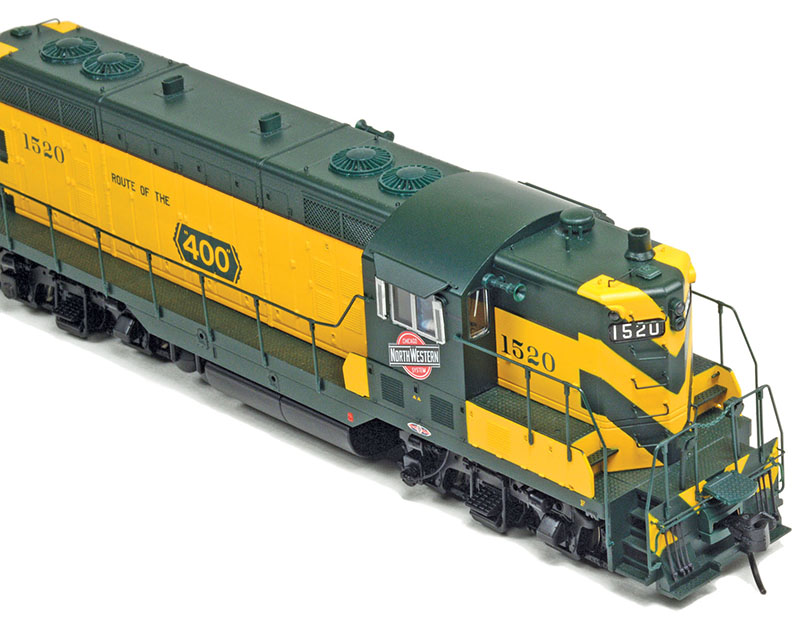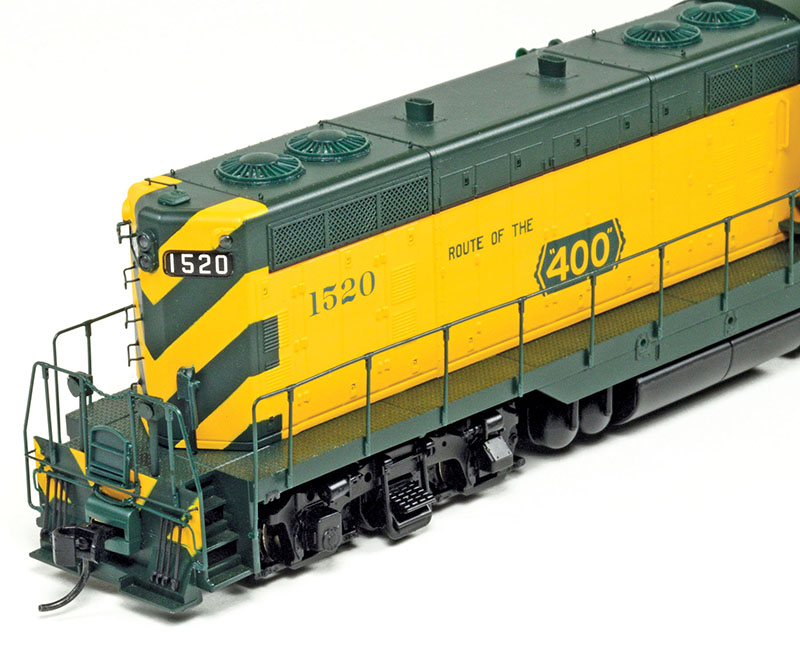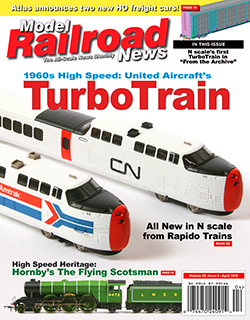 Review by Andy Dorsch/model photos by Tony Cook
Review by Andy Dorsch/model photos by Tony Cook
Ever since I was a little kid, I’ve always wanted to have an HO-scale Chicago & North Western (C&NW) GP7 for my model railroad. It was a dream of mine to recreate the scene where the old Chicago & North Western would send a lonely GP7 past my mom and dad’s house. However, when I was growing up, finding a decent model of a GP7, let alone having one painted Chicago & North Western, was very difficult.
Fast forward to today. Walthers recently released its revised Proto-series rendition of the Electro-Motive Division (EMD) GP7 diesel making this now big kid’s dream come true. The model I am reviewing is a Chicago & North Western GP7 numbered 1520. Road names released by Walthers for its Proto HO-scale GP7 offering include Baltimore & Ohio, Chicago & North Western, New York Central, and Pennsylvania Railroad. The GP7 models come in standard Direct Current (DC) or with Digital Command Control (DCC) and sound. DCC and sound models come powered with factory-installed SoundTraxx Tsunami sound for DCC. The model comes fully assembled, and multiple road numbers were produced for each road name.

The opposite side long hood features the “Route of the Streamliners” slogan. The cab includes a large “ball and bar” herald.
Prototype GP7 hits the Market
General Motors’ Electro-Motive Division (EMD) GP7 was a late entrant to the road switcher market in the second half of the 1940s. Alco had its first road switchers in the market in 1941. Baldwin built its first road switchers in 1946, and even Fairbanks-Morse got in the mix before EMD by releasing its first road switchers in 1947. Two more years would pass before EMD got in the road switcher game.
In 1949, EMD released its new general-purpose or “GP” road switcher; the 1,500 horsepower GP7. This locomotive was designed to perform in both freight and passenger service. Its duties ranged from kicking cars around in a yard, to branch line and main line service on road freight trains and passenger services.

C&NW 1524 leads two more torpedo-tube GP7s. The set of steam generator Geeps is shown at South Beloit, Ill., in 1963. —Jim Boyd photo, Kevin EuDaly collection
The GP7 chassis was based on EMD’s very popular F7. The major design change was the body no longer had the “covered wagon” appearance, but a “high visibility” long hood and short hood with cab between the hood sections. The GP7 used the same 567 16-cylinder prime mover as the F7. The GP7’s other major components such as the traction motors, cooling fans, blowers, and generator were all interchangeable with the popular F7. Having so many similarities to the EMD F7, but including the then-new hood design, made the GP7 a very attractive addition to railroads with F7s in service.
The early versions of the GP7 came equipped with a steam generator, so they could handle passenger service in cold weather areas. The new GP7 offered upgraded electric control to give the engineer a quick response throttle for ease and speed in switching jobs, according to the article by R.M. Jorgenson, “The North Western’s Original Geeps,” appearing in the Fall 2011 Northwestern Lines magazine. Its four-wheel truck design set on a nine-foot wheel base made the GP7 ideal for negotiating tight curves and turnouts with ease. EMD marketed this general-purpose locomotive as the diesel that can do it all, yard switching, local freights, helper service, local passenger, mixed trains, transfer service, excursion specials, along with having the capability of doing multiple unit (m.u.) operations.
C&NW Spotlight
The Chicago & North Western had one of the most prolific GP7 fleets in all of North America. In 1950, the C&NW started its love affair with the GP7 with its order for three units, C&NW 1518-1520. Overall, the railroad would place more orders and roster 381 GP7s! Some of the road’s GP7 roster was sold or traded for newer units, but the C&NW retained most of its GP7s for revenue service, until the railroad was purchased by Union Pacific in 1995.
The Chicago & North Western hosted a demonstration of the GP7 in 1950. Electro-Motive Division (EMD) sent three demonstrator units to the C&NW numbered 100, 200, and 300. It should be noted that EMD 100 was renumbered from its original 922 EMD designation. C&NW tested the GP7 for both freight and passenger service. The railroad found that GP7 fuel and water tank capacity was too small for its main line passenger operations. Some services included runs for hundreds of miles. This shortcoming didn’t stop the C&NW from immediately buying all three demonstrators “as-is.” The locomotives returned to EMD for outfitting with some minor upgrades and a new paint scheme. The demonstrators came back as C&NW numbers 1518, 1519, and 1520. The Chicago & North Western paid $134,000 in cash for each locomotive in 1950; today that locomotive would cost $1.4 million!
The first delivery of the C&NW GP7s had some very distinct features, a prominent steam generator on the short hood, angled pilots, and an early rendition of a winterization hatch for locomotive number 1520. Other features of the early C&NW GP7s included the air horns on both sides of the locomotive. On the engineer’s side the horn was located on the short hood side, and on the long hood on the fireman’s side.
All three GP7s received C&NW’s famous green and yellow scheme. The roof was painted green, and the long and short hoods were painted in yellow. The frame and trucks were painted black, as per the C&NW standard for road switchers. The paint scheme included chevrons on the ends of the locomotive and had “400” and “Streamliner” slogans on opposite sides of the long hood. The well-known Chicago & North Western “ball & bar” herald was located on the side of the cab below the window.
These three Geeps were part of the Chicago commuter service for 10 years before being transitioned to freight operations in 1960. Once shifted to freight service, locomotives 1518 and 1519 had water boiler tanks removed to add fuel capacity. C&NW 1519 and 1520 were fitted with m.u. connections located on the end platforms. The road assigned all three of these early GP7s to its Wisconsin division in the early 1960s. The trio remained in Wisconsin until being shipped to Oelwein, Iowa, for rebuilding in 1972.
Walthers Proto EMD GP7
Walthers’ HO-scale Proto EMD GP7 diesel model release comes in a very sharp looking package. The lettering is large, legible, and eye-catching. There is a clear window on the side of the box that lets you see the model inside. I’ve always liked to be able to see what I am buying.
Inside, the model is protected by a Styrofoam insert and a clear plastic model holder. Foam inserts protect the hand rails and roof details inside the clear model holder. Removing the model from the packaging was simple. At no point during the unboxing did I feel the model would pop out of its protective casing and hit the deck.
First Impressions
This model is a stunner! Once I removed the model from the packaging and got a good look at it, I was very impressed! I thought this model’s assembly was very good, and had great intricate details. The paint and lettering were crisp, and I could even make out the tiny EMD builder’s plate beneath the C&NW herald on the cab sides.
In addition to the wealth of separately applied details, the molded-on details were also impressive. The louvers and hood door details were very sharp. There was even rivet detail on the roof and doors, so those inclined to do so can count the rivets! One thing that really stood out on this model are its door handles on the hoods. These tiny elaborate features are extremely realistic and completely brought this model to life.

The Walthers Proto HO-scale EMD GP7 has unique prototype details including a steam generator. Locomotives outfitted with a steam generator were used for commuter or passenger service, but also saw freight use.
The Devil is in the Details – Long Hood
One of the first things that stood out was the placement of the horns on the long hood and short hood. I am accustomed to seeing horns appear on the roof of a unit, not on the sides. On this particular prototype, the horns are located on the sides of the long and short hood. This Walthers GP7 release captured the placement perfectly.
The radiator fan detail on the long hood has see-through vents that show off the fan blades. A few other things that stood out on the radiator fans is the rivet detail on the roof panels along with the appropriately sized lift rings. Each of these finer details was located according to the prototype and truly add a dimension of realism.
Following suit with the radiator fans, the exhaust stacks have the same high-fidelity detail. The exhaust stacks are correctly sized, and the surrounding panels have fine rivet detail. Often times this detail can be overlooked but is clearly on display with this model.
After thoroughly examining the roof of the long hood, I turned my attention to the sides and found the same high-level details. The radiator grilles have exceptional detail with the grates and the shutters visible, as well as the panel rivets. As I mentioned before, the door detail and other molded details have a high degree of realism, and the grab irons on the end are perfectly placed and perfectly sized.
Overall, looking at the long hood of this model gives you a feel for the level of detail Walthers is adding to its contemporary GP7 models. The only long hood detail that I felt was missing was the “boxy” winterization hatch that the prototype used on locomotive C&NW 1520. Having the hatch added would have added that last piece of prototype detail to make an already great model outstanding.
Cab
The cab details on the Walthers Proto GP7 are well done. The interior shows a seated engineer and seated fireman both looking forward toward the short hood. There isn’t more in the way of cab interior detail, as the rest of the locomotive innards are dedicated to the driveline components and adding weight. The cab window details really stand out on this model. The cab sun shades and wind guards help bring the cab to life, along with the louver and door details.
The only thing I noticed was the cab door windows did not have separately applied wipers; Walthers opted for a molded option here. I would have thought with all the other separately applied detail, Walthers would have followed suit and added cab door window wipers to an already well detailed cab. (Editor’s Note: this current group of HO-scale GP7s includes a revised cab and hood tooling. Watch for a coming feature on these revisions with images of past Proto 2000 and Walthers Proto Geeps comparing the designs and recent enhancements.)
Short Hood
I absolutely love the details that Walthers packed into the short hood of this Chicago & North Western GP7. The horn on the engineer’s side is in the correct place and orientation as per the prototype. The antenna and roof panel rivet detail is visible and matches the overall quality of the rest of the model. The number boards look sharp and have lettering that matches the prototype for these locomotives of that era. Also, the oversized steam generator is a detail that stands out and gives this model its signature look.

This Walthers Proto GP7 has clean and sharp number board lettering that accurately reproduces the Chicago & North Western prototype. During operation these number boards are back lit and provide an excellent lighting effect.
Paint
The paint job on Walthers’ C&NW GP7 is very clean and even, and presents a great prototypical appearance. Locomotive numbers and slogans are dramatic and truly pop in the C&NW early road switcher green and yellow paint scheme. The chevrons on the ends are sharp and have well-defined lines.
One compliment I should mention; as someone who has tried to paint C&NW locomotives myself, I can truly appreciate the clean and straight masking lines. According to my research, C&NW 1520 had hood end triangles that enveloped the whole headlight fixture, as opposed to coming to a point somewhere in the middle. This is the only thing that is lacking in this exquisite paint job, and I will admit this assertion is pretty nit-picky.
Trucks
The next area worth highlighting are the truck sideframes. This model has outstanding detail in this area. The journal bearing covers are a great feature that is prototypical to these Chicago & North Western Geeps. The sideframes have good molded-on details and the brake features are fully on display. There is a speed recorder on the engineer’s side that puts the cherry on top of the already loaded truck detail for this GP7.
Platforms, Walkways, and Pilots
The dimensional detail in the walkways and pilot steps adds yet another bit of character to these already highly detailed models. The tread on the walkways is in a diamond plate pattern and stands out. The steps are see-through and are all level in placement in the sides of the pilots. The handrails around the locomotive are very smooth and straight. The stanchions are at a solid perpendicular angle to the frame and walkways, which showcase the model’s quality.
Walthers did a wonderful job of capturing the first-generation GP7 slanted pilots. This feature is very noticeable on the early EMD road switcher and is a highlight on this HO reproduction. The pilot facings have great details, including coupler cut levers and m.u. hoses, both separately applied.
One complaint I have with the pilot handrails is they are not true to prototype for locomotive C&NW 1520. The locomotive did not have a chain in the center of the handrails; the railing was continuous. Also, C&NW 1520 did not have any coupler drop steps on the pilots, whereas these features are included with this model. One last detail I felt was excluded was an electrical conduit that ran along the walkway from the cab to the rear of the locomotive. This electrical conduit was critical to commuter train lighting.
Operational Test
The model I reviewed was a DC version with DCC-ready capabilities. The operation of the locomotive was smooth and the motor noise was almost non-existent. The locomotive responded quickly to the throttle and moved freely and smoothly down the rails. The headlights and number boards were very well lit and added a nice accent to the locomotive operation.
Final Thoughts
Overall, I feel that Walthers has created a very good replica of the early versions of Electro-Motive Division’s GP7. The countless prototype-specific details make this Proto-series model a very realistic and accurate depiction of the first-generation road switcher. It is very apparent that Walthers delivers a high-quality locomotive that is true to the prototype. Walthers’ rendition of the first-generation EMD GP7 has impressed me so much that I will find a way to incorporate this model into my fleet.
Andy Dorsch and his family reside in Ripon, Wis. Andy studied Geography and Urban & Regional Planning at the University of Wisconsin, which not only serves him for his work but likely is helpful in his model railroad planning. He is an accomplished model railroader who enjoys Chicago & North Western. You can see Andy’s hobby work and learn some model railroading tips by visiting his YouTube Channel. This is his first review for MODEL RAILROAD NEWS.
Walthers Proto HO-scale GP7 diesel locomotive
Chicago & North Western 1520 #920-49105, MSRP: $199.99
Wm. K. Walthers, Inc.
5601 W. Florist Ave.
Milwaukee, WI 53218
800-487-2467




